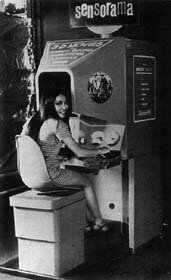Morton Heilig
MINDS THAT MATTER:
 MORTON HEILIG: GIVING US WHAT WE WANT
MORTON HEILIG: GIVING US WHAT WE WANT
Cinema that indulged the senses
Here was a man who was not only a pioneer, but someone who knew how to go after an audience. Morton Heilig, whom some currently crown as the father of virtual reality, was a cinematographer who invented the groundbreaking motion picture device Sensorama in 1962 in a bid to make film a fully immersive medium, tearing down its stubborn “fourth wall.” For the price of a quarter, for instance, customers could experience virtually firsthand what it was like to zoom through the streets of New York City while riding a motorcycle.
Heilig’s machine, which was considered a game and was fashioned like an arcade booth, was said to include “tactile feedback handlebars,” as is indicated in publicity photos and renderings of the contraption. Aside from its ability to deliver vibrations, Sensorama also generated stereoscopic 3-D images as well as aromas and sound. And there was an interesting concept behind the invention, which was first conceived by Heilig in roughly 1953.
The fundamental rationale was that an artist’s ability to express himself, as well as to manipulate audiences, could be enhanced by gaining scientific insights into what specifically engaged the human animal on both the cognitive and carnal levels. And here’s how Heilig broke it down. He held that each of the five senses engrossed individuals according to the following ratios: sight 70 percent, hearing 20 percent, smell 5 percent, touch 4 percent, taste 1 percent, according to numbers cited in author Ralph Schroeder’s nonfiction book, Possible Worlds.
The machine was said to be referred to by Heilig as the “Experience Theater” when it included 3-D glasses in 1969, and the “Sensorama Simulator” in 1971 for evoking reality. But as ahead of its time and as seemingly appealing as it was, the game flopped due to inability to generate revenue. It was a concept whose time was yet premature.
In fact, Heilig himself was said to have concluded that the machine “may have been too revolutionary for its time,” according to a feature spotlighting Heilig on a Web site called Retro Future. The page also cites virtual reality author and philosopher Howard Rheingold’s thoughts on the matter.
Putting the innovativeness of the invention into perspective, Rheingold noted generically that the technological hurdles that would make such a concept more feasible are only now starting to give way. Also worth noting, the home computer was not invented until the early 1970s, and the use and acceptance of this type of technology for simulation purposes was nonexistent in Heilig’s heyday.
– Noche Kandora
| FUN LINKS FOR FURTHER EXPLORATION: - ArtMuseum.net - Media Art Net - Retro Future - Sensomatic’s Sensorama: A Tribute to Sensorama - Telepresence.org - University of Southern California Interactive Media Division Weblog |
_______________________________________________________
Photo ID: Some sexy Sensorama model.
Photo source: ArtMuseum.net
_______________________________________________________
No Comments
No comments yet.
Leave a comment
You must be logged in to post a comment.











